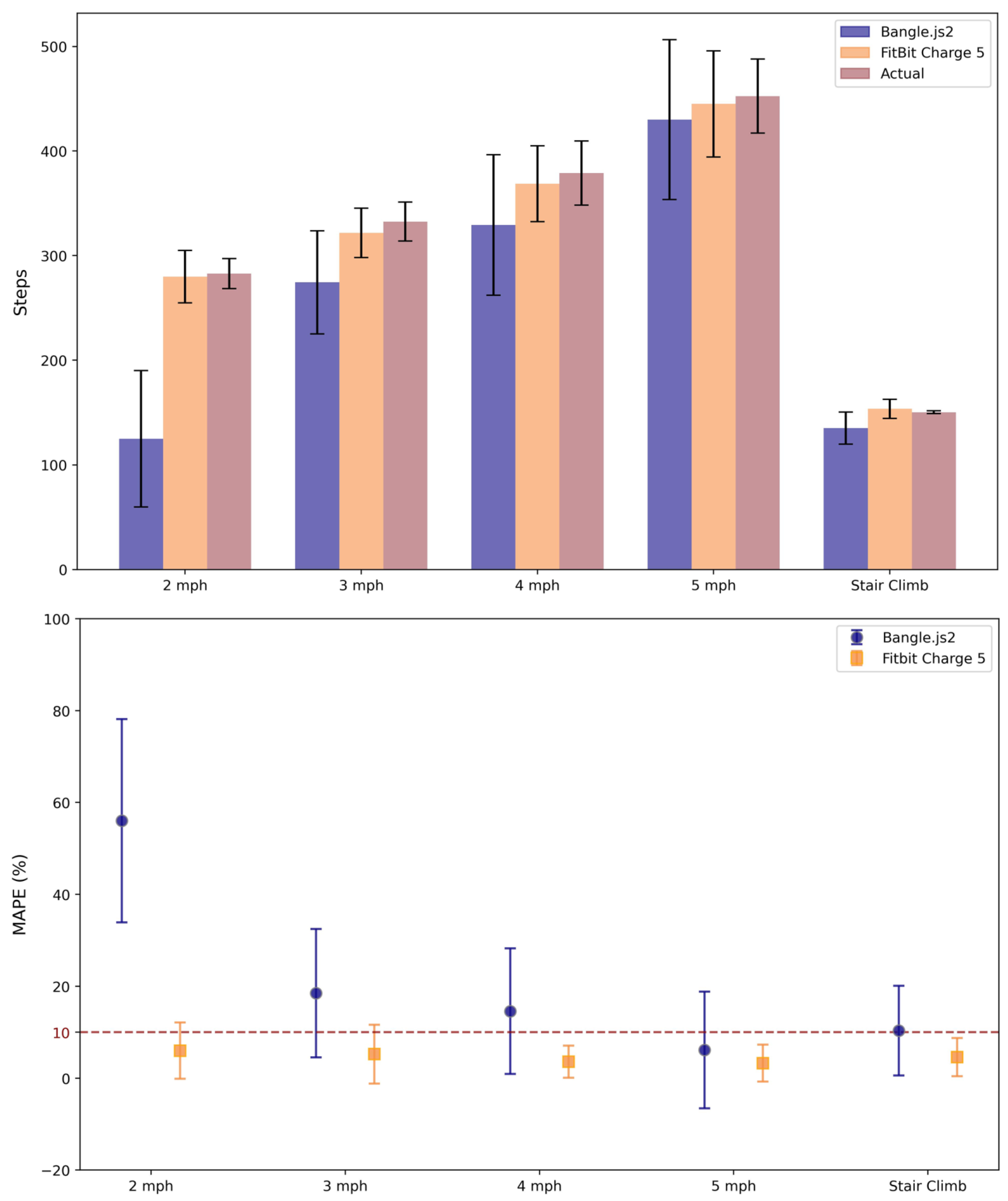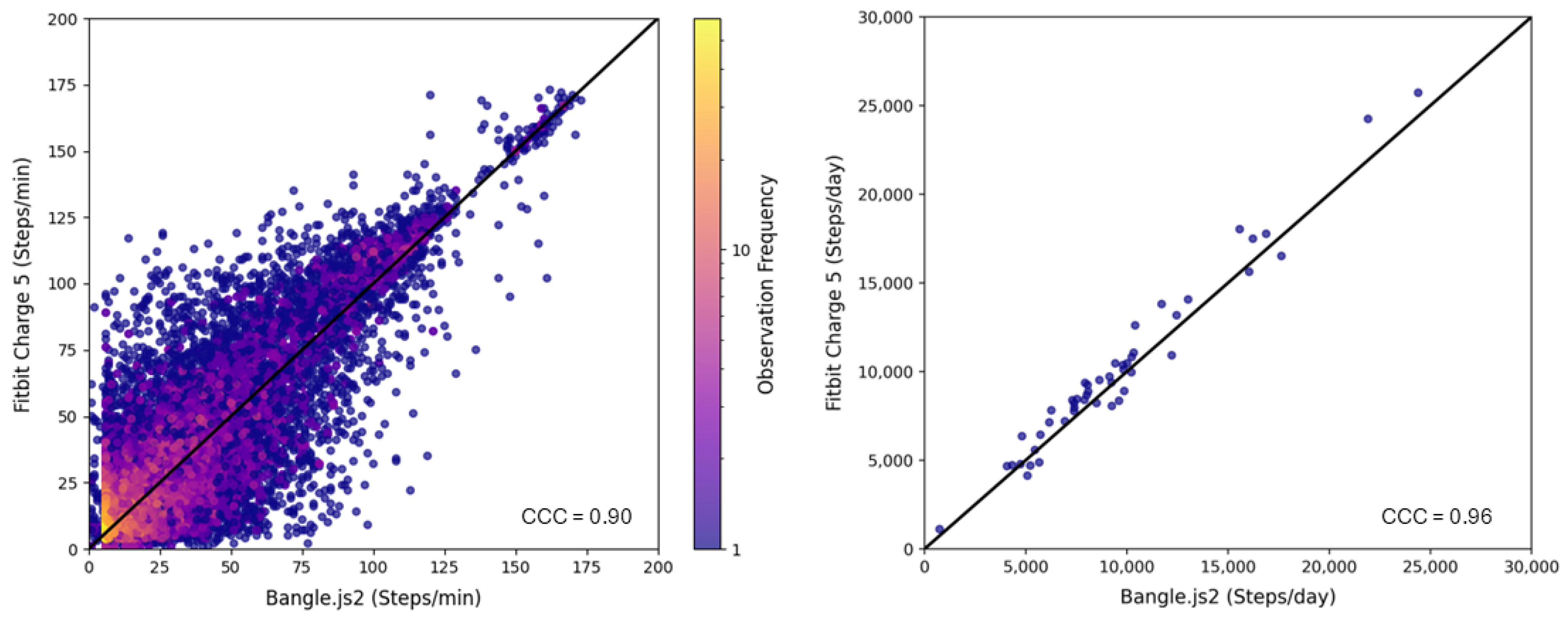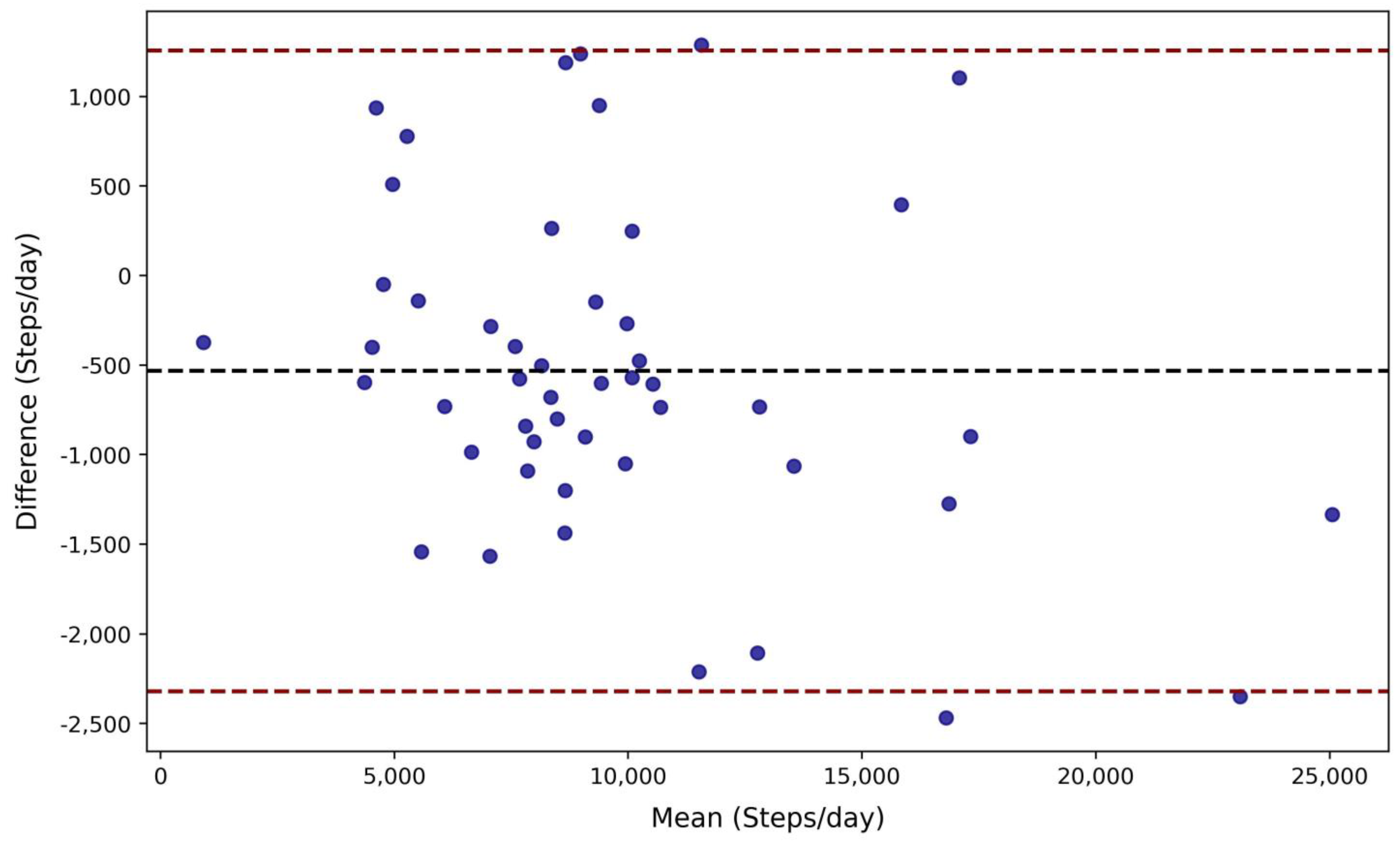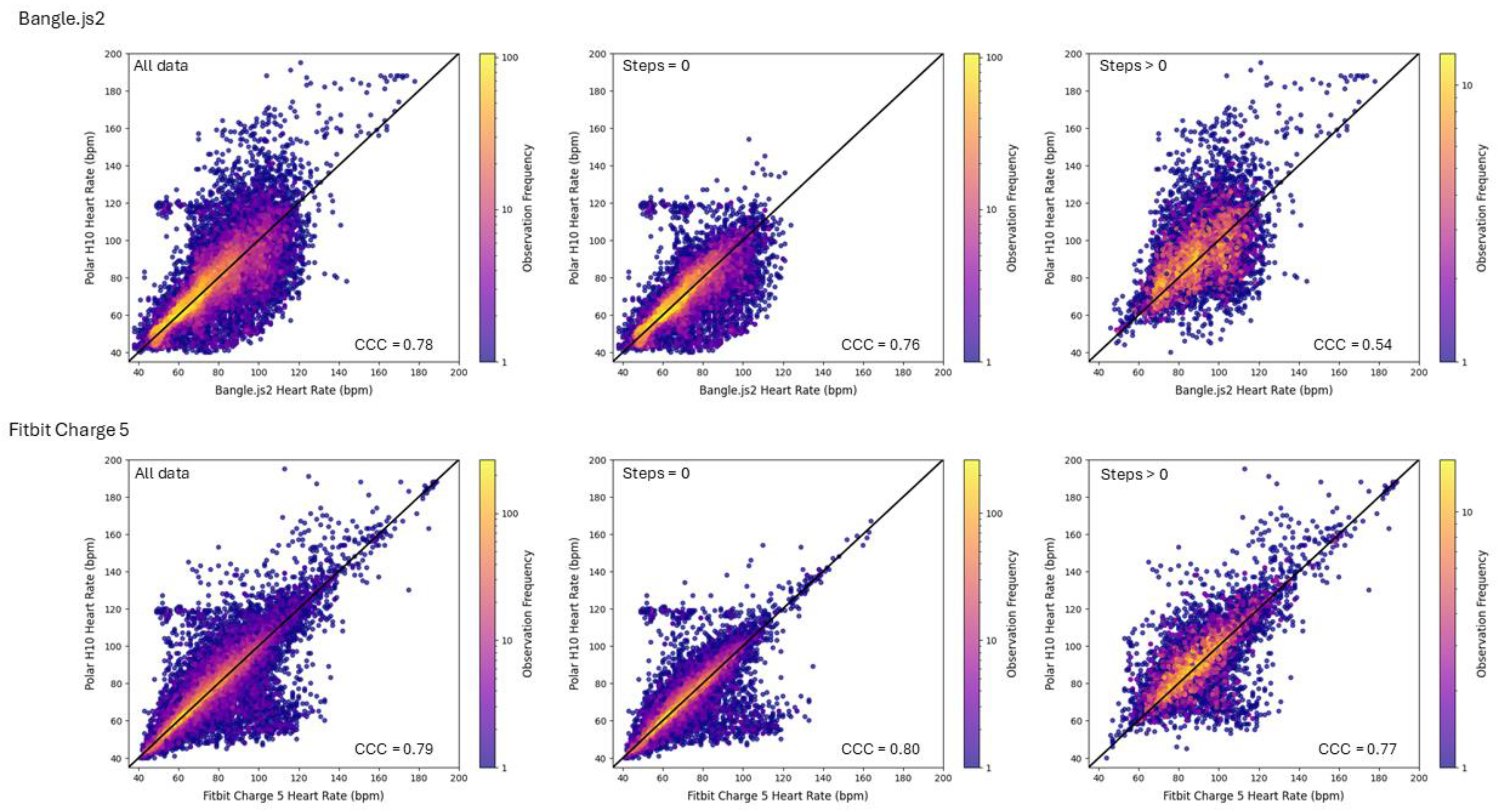Validation of an Open-Source Smartwatch for Continuous Monitoring of Physical Activity and Heart Rate in Adults
Abstract
1. Introduction
2. Methods
2.1. Ethical Approval and Recruitment
2.2. Procedures
2.3. Data and Statistical Analysis
3. Results
3.1. In-Person Data Collection
3.2. Twenty-Four-Hour Free-Living Steps
3.3. Heart Rate
4. Discussion
5. Conclusions
Author Contributions
Funding
Institutional Review Board Statement
Informed Consent Statement
Data Availability Statement
Acknowledgments
Conflicts of Interest
References
- Henriksen, A.; Mikalsen, M.H.; Woldaregay, A.Z.; Muzny, M.; Hartvigsen, G.; Hopstock, L.A.; Grimsgaard, S. Using Fitness Trackers and Smartwatches to Measure Physical Activity in Research: Analysis of Consumer Wrist-Worn Wearables. J. Med. Internet Res. 2018, 20, e110. [Google Scholar] [CrossRef] [PubMed]
- Shin, G.; Jarrahi, M.H.; Fei, Y.; Karami, A.; Gafinowitz, N.; Byun, A.; Lu, X. Wearable Activity Trackers, Accuracy, Adoption, Acceptance and Health Impact: A Systematic Literature Review. J. Biomed. Inform. 2019, 93, 103153. [Google Scholar] [CrossRef]
- Miyakoshi, T.; Ito, Y.M. Assessing the Current Utilization Status of Wearable Devices in Clinical Research. Clin. Trials 2024, 21, 470–482. [Google Scholar] [CrossRef] [PubMed]
- Getting Real with Wearable Data. Nat Biotechnol 2019, 37, 331. [CrossRef]
- Leung, W.; Case, L.; Sung, M.C.; Jung, J. A Meta-Analysis of Fitbit Devices: Same Company, Different Models, Different Validity Evidence. J. Med. Eng. Technol. 2022, 46, 102–115. [Google Scholar] [CrossRef]
- Cho, S.; Ensari, I.; Weng, C.; Kahn, M.G.; Natarajan, K. Factors Affecting the Quality of Person-Generated Wearable Device Data and Associated Challenges: Rapid Systematic Review. JMIR mHealth uHealth 2021, 9, e20738. [Google Scholar] [CrossRef]
- Sui, A.; Sui, W.; Liu, S.; Rhodes, R. Ethical Considerations for the Use of Consumer Wearables in Health Research. Digit. Health 2023, 9, 20552076231153740. [Google Scholar] [CrossRef]
- McKeon, J. 61M Fitbit, Apple Users Had Data Exposed in Wearable Device Data Breach. Health IT Security, 16 September 2021; p. 1. [Google Scholar]
- Janssen, M.; Brous, P.; Estevez, E.; Barbosa, L.S.; Janowski, T. Data Governance: Organizing Data for Trustworthy Artificial Intelligence. Gov. Inf. Q. 2020, 37, 101493. [Google Scholar] [CrossRef]
- Johnston, W.; Judice, P.B.; García, P.M.; Mühlen, J.M.; Skovgaard, E.L.; Stang, J.; Schumann, M.; Cheng, S.; Bloch, W.; Brønd, J.C.; et al. Recommendations for Determining the Validity of Consumer Wearable and Smartphone Step Count: Expert Statement and Checklist of the INTERLIVE Network. Br. J. Sports Med. 2021, 55, 780–793. [Google Scholar] [CrossRef]
- Gilgen-Ammann, R.; Schweizer, T.; Wyss, T. RR Interval Signal Quality of a Heart Rate Monitor and an ECG Holter at Rest and during Exercise. Eur. J. Appl. Physiol. 2019, 119, 1525–1532. [Google Scholar] [CrossRef]
- Fitzpatrick, T.B. The Validity and Practicality of Sun-Reactive Skin Types I Through VI. Arch. Dermatol. 1988, 124, 869–871. [Google Scholar] [CrossRef] [PubMed]
- Ho, B.K.; Robinson, J.K. Color Bar Tool for Skin Type Self-Identification: A Cross Sectional Study. J. Am. Acad. Dermatol. 2015, 73, 312–313.e1. [Google Scholar] [CrossRef] [PubMed]
- Ravanelli, N.; Lefebvre, K.; Mornas, A.; Gagnon, D. Evaluating Compliance with HeatSuite for Monitoring in Situ Physiological and Perceptual Responses and Personal Environmental Exposure. npj Digit. Med. 2025, 8, 223. [Google Scholar] [CrossRef]
- Williams, G. Bangle.Js App Loader 2024. Available online: https://banglejs.com/apps/ (accessed on 30 January 2025).
- Ravanelli, N.; Lin, W.; Richard, M.; Paquette, S.; Lefebvre, K.; Brough, A. Data and Code for Assessing the Agreement of the Bangle.Js2 during in-Lab and 24h Free-Living Conditions for Measuring Steps and Heart Rate. Open Sci. Framew. 2025. [Google Scholar] [CrossRef]
- Bent, B.; Goldstein, B.A.; Kibbe, W.A.; Dunn, J.P. Investigating Sources of Inaccuracy in Wearable Optical Heart Rate Sensors. npj Digit. Med. 2020, 3, 18. [Google Scholar] [CrossRef] [PubMed]
- Cadmus-Bertram, L.; Gangnon, R.; Wirkus, E.J.; Thraen-Borowski, K.M.; Gorzelitz-Liebhauser, J. The Accuracy of Heart Rate Monitoring by Some Wrist-Worn Activity Trackers. Ann. Intern. Med. 2017, 166, 610–612. [Google Scholar] [CrossRef]
- Cliff, N. Ordinal Methods for Behavioral Data Analysis; Psychology Press: New York, NY, USA, 2014; ISBN 978-1-315-80673-0. [Google Scholar]
- Wallen, M.P.; Gomersall, S.R.; Keating, S.E.; Wisløff, U.; Coombes, J.S. Accuracy of Heart Rate Watches: Implications for Weight Management. PLoS ONE 2016, 11, e0154420. [Google Scholar] [CrossRef]
- Consumer Technology Association Health and Fitness Technology Subcommittee. Physical Activity Monitoring for Fitness Wearables: Step Counting; Consumer Technology Association: Arlington, TX, USA, 2016. [Google Scholar]
- Moore, C.C.; McCullough, A.K.; Aguiar, E.J.; Ducharme, S.W.; Tudor-Locke, C. Toward Harmonized Treadmill-Based Validation of Step-Counting Wearable Technologies: A Scoping Review. J. Phys. Act. Health 2020, 17, 840–852. [Google Scholar] [CrossRef]
- Consumer Technology Association. Physical Activity Monitoring for Heart Rate—Real World Analysis (ANSI/CTA-2065.1); Consumer Technology Association: Arlington, TX, USA, 2023. [Google Scholar]
- Bassett, D.R.; Toth, L.P.; LaMunion, S.R.; Crouter, S.E. Step Counting: A Review of Measurement Considerations and Health-Related Applications. Sports Med. 2017, 47, 1303–1315. [Google Scholar] [CrossRef]
- Mora-Gonzalez, J.; Gould, Z.R.; Moore, C.C.; Aguiar, E.J.; Ducharme, S.W.; Schuna, J.M.; Barreira, T.V.; Staudenmayer, J.; McAvoy, C.R.; Boikova, M.; et al. A Catalog of Validity Indices for Step Counting Wearable Technologies during Treadmill Walking: The CADENCE-Adults Study. Int. J. Behav. Nutr. Phys. Act. 2022, 19, 117. [Google Scholar] [CrossRef]
- Small, S.; Khalid, S.; Dhiman, P.; Chan, S.; Jackson, D.; Doherty, A.; Price, A. Impact of Reduced Sampling Rate on Accelerometer-Based Physical Activity Monitoring and Machine Learning Activity Classification. J. Meas. Phys. Behav. 2021, 4, 298–310. [Google Scholar] [CrossRef]
- Chow, H.-W.; Yang, C.-C. Accuracy of Optical Heart Rate Sensing Technology in Wearable Fitness Trackers for Young and Older Adults: Validation and Comparison Study. JMIR mHealth uHealth 2020, 8, e14707. [Google Scholar] [CrossRef] [PubMed]
- Liang, Y.; Elgendi, M.; Chen, Z.; Ward, R. An Optimal Filter for Short Photoplethysmogram Signals. Sci. Data 2018, 5, 180076. [Google Scholar] [CrossRef] [PubMed]
- Pollreisz, D.; TaheriNejad, N. Detection and Removal of Motion Artifacts in PPG Signals. Mob. Netw. Appl. 2022, 27, 728–738. [Google Scholar] [CrossRef]
- Van Laerhoven, K.; Hoelzemann, A.; Pahmeier, I.; Teti, A.; Gabrys, L. Validation of an Open-Source Ambulatory Assessment System in Support of Replicable Activity Studies. Ger. J. Exerc. Sport Res. 2022, 52, 262–272. [Google Scholar] [CrossRef]
- Gao, Z.; Liu, W.; McDonough, D.J.; Zeng, N.; Lee, J.E. The Dilemma of Analyzing Physical Activity and Sedentary Behavior with Wrist Accelerometer Data: Challenges and Opportunities. J. Clin. Med. 2021, 10, 5951. [Google Scholar] [CrossRef]
- Yuan, H.; Chan, S.; Creagh, A.P.; Tong, C.; Acquah, A.; Clifton, D.A.; Doherty, A. Self-Supervised Learning for Human Activity Recognition Using 700,000 Person-Days of Wearable Data. npj Digit. Med. 2024, 7, 91. [Google Scholar] [CrossRef]
- Zhang, S.; Li, Y.; Zhang, S.; Shahabi, F.; Xia, S.; Deng, Y.; Alshurafa, N. Deep Learning in Human Activity Recognition with Wearable Sensors: A Review on Advances. Sensors 2022, 22, 1476. [Google Scholar] [CrossRef]
- Mühlen, J.M.; Stang, J.; Skovgaard, E.L.; Judice, P.B.; Molina-Garcia, P.; Johnston, W.; Sardinha, L.B.; Ortega, F.B.; Caulfield, B.; Bloch, W.; et al. Recommendations for Determining the Validity of Consumer Wearable Heart Rate Devices: Expert Statement and Checklist of the INTERLIVE Network. Br. J. Sports Med. 2021, 55, 767–779. [Google Scholar] [CrossRef]
- Koerber, D.; Khan, S.; Shamsheri, T.; Kirubarajan, A.; Mehta, S. Accuracy of Heart Rate Measurement with Wrist-Worn Wearable Devices in Various Skin Tones: A Systematic Review. J. Racial Ethn. Health Disparities 2023, 10, 2676–2684. [Google Scholar] [CrossRef]







| Lab Validation (n = 23) | 24 h Step Counting (n = 47) | 24 h Heart Rate (n = 26) | |
|---|---|---|---|
| Male/Female | 15/8 | 25/22 | 12/14 |
| Age (y) | 23.0 ± 3.6 | 26.7 ± 11.3 | 30.1 ± 14.2 |
| Height (cm) | 178 ± 10 | 176 ± 9 | 174 ± 9 |
| Weight (kg) | 80.6 ± 14.1 | 78.0 ± 12.9 | 75.9 ± 11.0 |
| BMI | 25.5 ± 4.4 | 25.2 ± 3.7 | 24.9 ± 2.8 |
| Fitzpatrick Skin Type | - | - | 2.8 ± 0.9 |
| June Robinson Skin Tone | - | - | 1.5 ± 0.7 |
| Condition | Device | MAE [95% CI] | MAPE [95% CI] | MdAPE [95% CI] | TE [95% CI] |
|---|---|---|---|---|---|
| 2 mph | Bangle.js2 | 158 [134, 182] | 56.0 [47.4, 64.7] | 56.5 [35.9, 71.1] | 169 [145, 194] |
| Fitbit Charge 5 | 17 [10, 24] | 6.0 [3.6, 8.4] | 4.8 [2.4, 6.4] | 24 [15, 33] | |
| 3 mph | Bangle.js2 | 62 [43, 82] | 14.3 [13.0, 24.0] | 14.3 [0.3, 23.3] | 79 [58, 100] |
| Fitbit Charge 5 | 18 [9, 27] | 5.2 [2.7, 7.7] | 3.1 [1.2, 4.3] | 29 [18, 39] | |
| 4 mph | Bangle.js2 | 55 [35, 75] | 14.6 [9.2, 19.9] | 11.0 [4.9, 17.4] | 75 [53, 97] |
| Fitbit Charge 5 | 13 [8, 19] | 3.6 [2.2, 4.9] | 2.1 [1.4, 4.0] | 19 [13, 25] | |
| 5 mph | Bangle.js2 | 25 [6, 45] | 6.1 [1.2, 11.1] | 0.8 [0.7, 2.0] | 56 [36, 75] |
| Fitbit Charge 5 | 14 [8, 20] | 3.3 [1.7, 4.8] | 2.3 [1.2, 3.1] | 21 [13, 28] | |
| Stair Climb | Bangle.js2 | 16 [10, 21] | 10.3 [6.5, 14.2] | 6.7 [4.7, 12.0] | 21 [15, 27] |
| Fitbit Charge 5 | 7 [4, 9] | 4.6 [2.9, 6.2] | 3.3 [1.3, 6.7] | 9 [6, 13] |
| Sample (n) | CCC [95% CI] | MAE [95% CI] | MAPE [95% CI] | MdAPE [95% CI] | TE [95% CI] | Bland–Altman Bias [LoA] | Cliff’s Delta | |
|---|---|---|---|---|---|---|---|---|
| Minute-by-minute steps | 68,873 | 0.90 [0.90, 0.90] | 3.5 [3.5,3.6] | - | - | 9.3 [9.3, 9.4] | 0.2 [−18.1, 18.5] | −0.014 |
| Total 24 h steps | 49 | 0.96 [0.94, 0.96] | 1025.7 [810.2, 1241.2] | 11.0 [8.5, 13.5] | 8.0 [−11.4, 31.7] | 1282.3 [11.9, 12.1] | −531 [−2320, 1257] | - |
| Sample (n) | CCC [95% CI] | MAE [95% CI] | MAPE [95% CI] | MdAPE [95%CI] | TE [95% CI] | Bland–Altman Bias [LoA] | Cliff’s Delta | |
|---|---|---|---|---|---|---|---|---|
| All observations (vs. Polar H10) | ||||||||
| Bangle.js2 | 30,598 | 0.78 [0.78, 0.78] | 7.2 [7.1, 7.3] | 9.3 [9.2, 9.4] | 5.7 [5.5, 5.7] | 11.8 [11.7, 11.9] | −0.3 [−23.2, 22.5] | −0.006 |
| Fitbit Charge 5 | 30,549 | 0.79 [0.79, 0.79] | 5.4 [5.3, 5.5] | 6.9 [6.8, 7.1] | 2.8 [2.8, 3.0] | 12.0 [11.9, 12.1] | −0.3 [−19.5, 18.8] | 0.010 |
| Sedentary (e.g., 0 Steps, vs. Polar H10) | ||||||||
| Bangle.js2 | 23,322 | 0.76 [0.76, 0.77] | 5.6 [5.5, 5.7] | 8.1 [7.9, 8.2] | 4.9 [4.8, 5.0] | 9.5 [9.4, 9.6] | −0.3 [−18.0, 18.6] | −0.013 |
| Fitbit Charge 5 | 23,181 | 0.80 [0.80, 0.80] | 3.9 [3.8, 4.0] | 5.6 [5.4, 5.7] | 2.2 [2.1, 2.2] | 8.6 [8.5, 8.7] | −0.0 [−16.5, 16.4] | −0.007 |
| Active (e.g., >0 Steps, vs. Polar H10) | ||||||||
| Bangle.js2 | 7276 | 0.54 [0.53, 0.56] | 12.5 [12.2, 12.7] | 13.2 [12.9, 13.5] | 9.9 [9.7, 10.3] | 17.2 [16.8, 17.6] | −2.4 [−35.7, 30.8] | 0.039 |
| Fitbit Charge 5 | 7242 | 0.77 [0.76, 0.78] | 8.6 [8.4, 8.9] | 9.7 [9.4, 9.9] | 6.1 [5.8, 6.2] | 13.0 [12.7, 13.3] | −1.4 [−25.0, 27.7] | 0.052 |
Disclaimer/Publisher’s Note: The statements, opinions and data contained in all publications are solely those of the individual author(s) and contributor(s) and not of MDPI and/or the editor(s). MDPI and/or the editor(s) disclaim responsibility for any injury to people or property resulting from any ideas, methods, instructions or products referred to in the content. |
© 2025 by the authors. Licensee MDPI, Basel, Switzerland. This article is an open access article distributed under the terms and conditions of the Creative Commons Attribution (CC BY) license (https://creativecommons.org/licenses/by/4.0/).
Share and Cite
Ravanelli, N.; Lefebvre, K.; Brough, A.; Paquette, S.; Lin, W. Validation of an Open-Source Smartwatch for Continuous Monitoring of Physical Activity and Heart Rate in Adults. Sensors 2025, 25, 2926. https://doi.org/10.3390/s25092926
Ravanelli N, Lefebvre K, Brough A, Paquette S, Lin W. Validation of an Open-Source Smartwatch for Continuous Monitoring of Physical Activity and Heart Rate in Adults. Sensors. 2025; 25(9):2926. https://doi.org/10.3390/s25092926
Chicago/Turabian StyleRavanelli, Nicholas, KarLee Lefebvre, Amy Brough, Simon Paquette, and Wei Lin. 2025. "Validation of an Open-Source Smartwatch for Continuous Monitoring of Physical Activity and Heart Rate in Adults" Sensors 25, no. 9: 2926. https://doi.org/10.3390/s25092926
APA StyleRavanelli, N., Lefebvre, K., Brough, A., Paquette, S., & Lin, W. (2025). Validation of an Open-Source Smartwatch for Continuous Monitoring of Physical Activity and Heart Rate in Adults. Sensors, 25(9), 2926. https://doi.org/10.3390/s25092926





